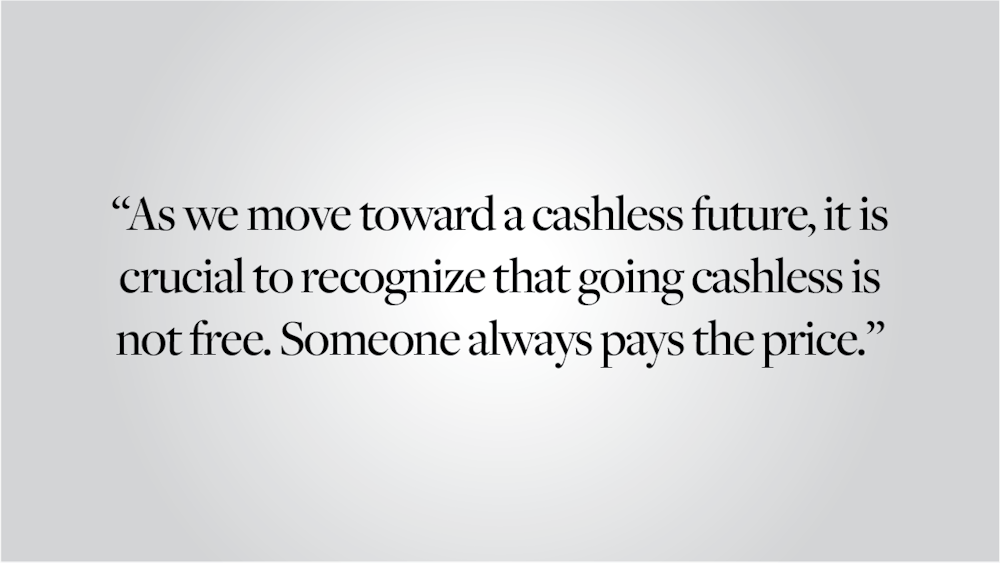“Cash or card?”
We’ve become so accustomed to hearing this question, asking us to pick our preferred payment method. But how would we feel if this commonly asked question suddenly became irrelevant?
The erasure of cash is not a hypothetical scenario. Bringing a new social aversion to physical contact and prolonged transactions, the COVID-19 pandemic has accelerated the shift from cash to digital payment. Stores have allowed customers to pay in cash for years, but an increasing number of businesses are now doing the opposite, favoring digital payment methods and eliminating cash transactions altogether. There are even proposals for entirely cashless cities. However, as we move toward a cashless future, it is crucial to recognize that going cashless is not free.
Let’s face it: Operating in cash is cumbersome for consumers, businesses and banks. Personally, I like to avoid scrounging for pennies at the bottom of my bag or standing behind someone in line who does. Cash comes with its fair share of frustrations, but the costs associated with the payment method are perhaps more substantial. The technical issues associated with transporting and dealing with cash can cost retailers anywhere between 4.7% to 15.3% of the cash value earned, outweighing the cost of credit card fees on the same transactions. When I worked as a cashier at my local bubble tea store, I often hoped that customers would pay with cards so I wouldn’t have to unravel coin rolls or recount bills at the end of my shift.
Despite the efficiency and ease of card payment, however, we must take into account groups that get shut out from a cashless system. Teenagers, low-income families and minority groups are more likely to use cash. This is because cash itself is accessible, anonymous and indiscriminate, whereas credit cards require users to have a bank account — which not everyone does. Approximately 5.9 million “U.S. households were ‘unbanked’ in 2021, meaning no one in the household had a checking or savings account,” according to the Federal Deposit Insurance Corporation. Even individuals who do hold cards may not necessarily want to increase their credit card debt, instead preferring to use cash. It is these concerns around equity and accessibility that have caused legislators across the country, including in Rhode Island in 2019, to ban cashless stores at the state and local levels.
Moreover, cash might be the only option for some elders in our community. While electronic and card payments may appear procedurally simple to younger generations, they involve a fundamental change in habits for people accustomed to the tangibility of cash. During my time as a cashier, an elderly man came in every other day to order tea and use the store’s restroom. He could only pay in cash. Around 70% of boomers and those 72 and older prefer cash, according to AARP. This preference could be for various reasons, such as concerns over spending control and distrust or unfamiliarity with newer technology. The transition toward a cashless future may exclude these elders from the economy.
Even for those of us who enjoy the ease of credit and debit cards, there are still notable drawbacks to the cashless system. For one, in exchange for convenience, customers often pay with their privacy. With every payment recorded digitally, the electronic money trails you leave may allow companies and governments to harvest your personal data. Another downside is the omnipresent threat of cyber attacks. Compared to bank robberies, cyber attacks can be harder to predict and protect against. In March 2019, a solo hacker managed to steal 106 million people’s personal details in a matter of days. This attack was only noticed by Capital One a few months after the fact.
When paying with a card alone, you could also experience the cashless effect, or the tendency to be much looser with money when it isn’t tangible. While we may feel the “pain of payment” when we part with physical cash, we often subconsciously forget that credit card swipes are money we later have to repay. This cognitive bias means we have less difficulty parting with money when it only exists in a hypothetical, digital form. The cashless effect can cause us to spend more than we would have if we had to make that purchase with physical cash. This Black Friday, as merchants flood our social media feeds with promotions and hefty discounts, we must be mindful of our purchase decisions and avoid overspending with the easy swipe of a card.
A cashless economy may sound like progress, but it’s not a step forward for all of us, nor is it without downsides even for those of us in a position to take advantage of it. As the economy is increasingly digitized, we must both reflect on our own spending habits and ensure that the vulnerable in society aren’t left behind.
Christina Peng ’26 can be reached at christina_peng@brown.edu. Please send responses to this opinion to letters@browndailyherald.com and other op-eds to opinions@browndailyherald.com.
Editors’ Note: A previous version of this column contained sentences with identical or nearly identical language to an opinion column in the New York Times. A previous title also included language appearing in the New York Times column. These portions have since been revised.





